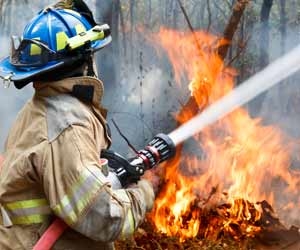Forest Service Firefighter Employment Outlook
Forest Service Fire and Aviation Management oversee the fire prevention, suppression and management personnel who work to keep America’s parks safe throughout the year.

The accomplishment of this goal requires a great deal of manpower and a diverse array of personnel. Although the National Forest Service does maintain a contingent of year round employees for fire prevention and suppression, most firefighting positions are seasonal due to the highly seasonal nature of wildland fires themselves. Personal Protective Equipment (PPE) clothing and fire shelters are provided to Forest Service fire suppression employees, but you will have to bring your own boots.
FACT! Over four out of five forest fires are caused by human negligence. Smoking and improperly extinguished campfires are among the most common culprits.
Job Descriptions
Let’s take a quick look at the most commonly hired seasonal positions:
- Forestry Aids work with foresters and fire crew managers to assist in fire prevention duties such as prescribed burning, brush thinning, ditch digging and control line preparation. They may also handle radio dispatch and communication during fire suppression activities.
- Type 1 Hand Crews are also known as hotshot crews because they often find themselves in the midst of the hottest parts of the fire during an event. They specialized in setting up fire control lines and handling ground fire suppression techniques using a variety of tools and equipment. When not engaged in a wildland fire event, hotshot crew duties include vegetation thinning, implementation of prescribed fire prevention strategies, habitat improvement and trail construction. They are also occasionally called in to help during search and rescue or disaster response missions. Most hotshot crew positions are seasonal, with employment dates starting in May and ending around October.
- Smokejumpers are considered to be a national resource. Rather than holding a static assignment in one particular region, they travel all over the nation providing a swift initial attack on remote wildland fires. In between fire events, smokejumpers are assigned to natural resource projects, performing such duties as brush piling, controlled burning, facilities construction and maintenance, and trail repair and maintenance. Seasonal smokejumpers typically work from June through October.
FACT! Federal agencies spend over one billion dollars per year fighting wildfires, often having to appropriate funds originally meant for other projects.
Qualifications and Training
Besides the training required for wildland firefighting, there are a few stipulations regarding applicants for hazardous duty positions such as firefighting. To be hired as a firefighter, you must:
- Be at least 18 years of age
- Be a citizen of the United States
- Pass a doctor administered firefighter physical with specific mobility, dexterity and hearing tests
- Pass a physical fitness test specific to firefighters
- Have no history of heart, lung, intestinal or nervous disorders
There are no educational requirements except the completion of basic wildland firefighter training, as well as any specialized training needed for specific positions. A high school diploma is not required. Basic wildland firefighter training includes 32 hours of field and classroom training. The training consists of instruction on incident organization, command, and responsibilities, wildland fire suppression techniques, dealing with the environmental factors that can affect fire behavior, use of equipment, tools and safety, and field exercises simulating wildland fire events.
The training consists of instruction on incident organization, command, and responsibilities, wildland fire suppression techniques, dealing with the environmental factors that can affect fire behavior, use of equipment, tools and safety, and field exercises simulating wildland fire events.
Hotshot training emphasizes identifying critical safety issues in the field and demonstrating appropriate responses. The program includes instruction on fire behavior, firefighter safety, fire shelter deployment, job hazard analysis, risk management, communications and field drilling on various fire suppression techniques. In addition, hotshot trainees must undergo rigorous physical fitness and conditioning programs, such as passing an arduous work capacity test where they are required to hike three miles in forty-five minutes while carrying a forty-five pound pack.
Smokejumper duties require extreme physical skill and stamina. To qualify for smokejumper training, firefighters must already have extensive field experience in wildland firefighting, be in excellent physical and mental condition, and pass height, weight and health requirements. During the smokejumper training, they become familiar with aircraft exiting procedures, parachute landing rolls, chute and cargo retrieval, timber let-down procedures and tree climbing. Experienced smokejumpers undergo periodic refresher training on the same techniques and procedures.
Fire management techniques and programs are constantly evolving in response to advances in science and technology, changes in policy and lessons learned in the field. Firefighters and fire management personnel are required to attend continuing education courses to stay up to date in the field.


 Teach English in Asia
Teach English in Asia  Cruise Ship Jobs
Cruise Ship Jobs  Alaska Fishing Industry Jobs
Alaska Fishing Industry Jobs  Sharing Economy / Gig Economy
Sharing Economy / Gig Economy